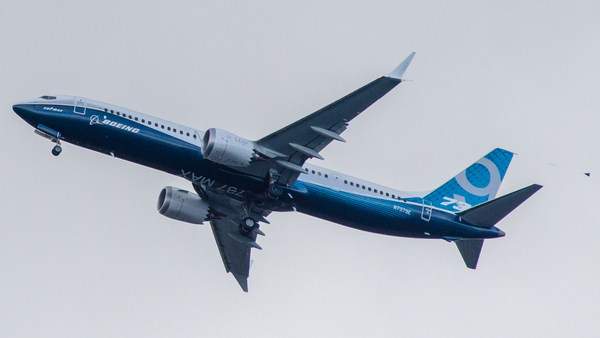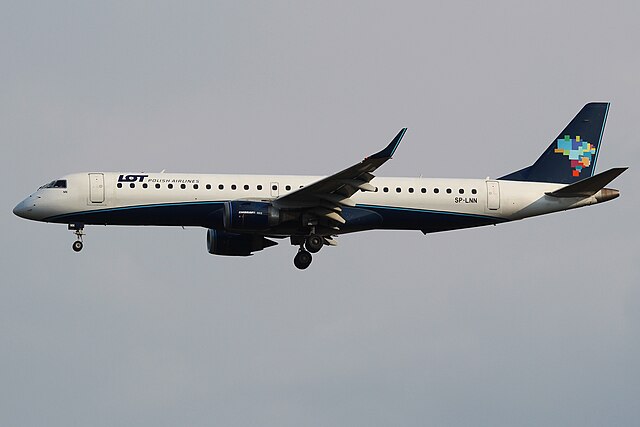Link SF34 at Sydney on Oct 24th 2022, too low of final ILS approach
Last Update: April 24, 2024 / 10:23:59 GMT/Zulu time
Incident Facts
Date of incident
Oct 24, 2022
Classification
Incident
Airline
Link Airways
Flight number
VA-669
Departure
Canberra, Australia
Destination
Sydney, Australia
Aircraft Registration
VH-VEQ
Aircraft Type
SAAB 340
ICAO Type Designator
SF34
Airport ICAO Code
YSSY
Australia's TSB rated the occurrence a serious incident regarding avionics/flight instruments and opened an investigation.
On Apr 24th 2024 the ATSB released their final report concluding the probable causes of the serious incident were:
Contributing factors
- During an instrument landing system approach, an undetermined instrumentation fault resulted in an erroneous on-glideslope indication being presented constantly on the left electronic attitude direction indicator and intermittently on the right electronic attitude direction indicator.
- The erroneous on-glideslope indications were presented without a fault indication and regardless of the aircraft's actual position relative to the glideslope. When the autopilot did not descend the aircraft along the glideslope as expected, the crew initiated a manual descent.
- The crew subsequently re-engaged the autopilot as the aircraft descended at a rate exceeding that required for the approach. The autopilot maintained the excessive descent rate, and the aircraft descended significantly below the glideslope.
Other findings
- As the aircraft descended below about 1,000 ft above ground level while about 380 ft below the glideslope, the ground proximity warnings system activated, and the crew recognised that the approach was not stabilised. In response, they commenced a missed approach.
The ATSB analysed:
Instrumentation fault
Following the incident, testing found the left (captain’s) display processor unit (DPU) to be faulty and it was removed from the aircraft and replaced. Since replacing the DPU, there have been no additional reports of erroneous glideslope indications on this aircraft. This indicates that the DPU was potentially the source of the false indications, although this could not be conclusively determined. The DPU was shipped to the manufacturer where a teardown of the unit was undertaken, and several failed components identified. However, when analysing the occurrence, the manufacturer reported that the failure indications were more consistent with an issue originating from the navigation radio. Both the aircraft and instrumentation manufacturers reported that this was the only known failure of its kind in the history of the aircraft type or on other aircraft equipped with the Pro Line 4 electronic flight instrument system.
While the precise source of the error could not be determined, it resulted in a constant on-glideslope indication on the captain’s electronic attitude direction indicator (EADI) regardless of the aircraft's position relative to the glideslope. The indications were presented with no glideslope or DPU failure indication.
The first officer also reported similar erroneous indications on their EADI during the approach and made several comments about the glideslope that were recorded by the cockpit voice recorder.
These comments often referred to a glideslope indication that differed from the recorded position of the aircraft. While the first officer’s glideslope indications were not recorded by the flight data recorder, these statements, the first officer’s reported observations and the recorded glideslope values indicated that the erroneous glideslope indications were also, at least intermittently, presented on the first officer’s EADI. However, as the aircraft descended below 1,000 ft, this EADI began presenting a correct fly-up indication.
After the flight, the captain stated that the indications on the standby ILS indicator were also erroneous. The standby indicator’s input signals were not provided by the faulty DPU, and the glideslope indications displayed were not recorded by the flight data recorder. There was also no comment made by the crew referring to the standby ILS during the flight. Consequently, it could not be determined what indications were present.
Descent below glideslope and recovery
The erroneous on-glideslope indications were presented to the crew without any glideslope fault indications so the crew were not alerted to the instrumentation failure by the system. The aircraft commenced the approach at a position close to the glideslope. This positioned the erroneous indication close to the expected and correct glideslope indication. Furthermore, both EADIs very likely presented similar erroneous glideslope indications and the localiser indications were presented correctly. Therefore, when the autopilot did not descend the aircraft along the glideslope as anticipated, the crew were not immediately alerted to a potential instrumentation failure. Instead, the crew assessed that the autopilot was probably experiencing a lag in capturing the glideslope and the captain responded by disconnecting the autopilot and manually descending the aircraft to follow the glideslope.
The crew subsequently observed unusual glideslope indications and completed several altitude and distance checks in an attempt to understand the conflicting indications. As the aircraft descended close to the glideslope and with an on-glideslope indication, the captain re-engaged the autopilot. However, this occurred when the aircraft was descending at an excessive rate for the approach, the implication of which did not appear to be recognised by the crew. As the aircraft continued the excessive descent rate, the instruments continued to show erroneous on-glideslope indications and the aircraft subsequently descended below the glideslope.
As the aircraft descended below 1,000 ft AMSL while significantly below the glideslope, the aircraft penetrated the ground proximity warning system warning envelope and a ‘glideslope’ alert sounded. At about the same time, the first officer’s EADI began showing correct glideslope indications. At that point the crew recognised the approach was unstable and immediately commenced a missed approach.
No NOTAMs regarding the ILS 34L were issued related to the occurrence. The NOTAMs however suggest that work on runway 34L was about to commence about 3 hours after the occurrence. Possibly related NOTAM:
H6083/22 NOTAMR H6059/22
Q) YMMM/QMTCM/IV/NBO/A/000/999/3357S15111E005
A) YSSY
B) 2210241200 C) 2210251900
D) DAILY 1200/1900
SUN-FRI 1200-1900
E) RWY 16R/34L 1738M NORTH END NOT AVBL DUE WIP
END RWY 34L 2224M FM RWY 34L START OF TKOF AND MARKED BY RED LGT
ALL TWY INT WITH RWY 16R/34L NORTH TWY B8 NOT AVBL
MEN AND EQPT ON NON-ACTIVE SECTION OF RWY NORTH OF TWY K INT
DECLARED DISTANCE AND GRADIENT CHANGES
RWY TORA TODA ASDA LDA
16R 2142 2232(2.37) 2172 -
34L - - - 2224
SUPPLEMENTARY TKOF DISTANCES
RWY16R- 2135(1.6) 2180(1.9) 2214(2.2)
START OF TKOF RWY 16R AT TWY B8
LDG RWY 34L LAST AVBL EXIT TWY B8
INT DEP FM TWY B8 REMAINING 2142M
RWY 16R HIGH INTST APCH LGT NOT AVBL
RCLL NOT AVBL
HIGH INTST RWY LGT NOT AVBL
LDG RWY 16R NOT AVBL
DEP RWY 34L NOT AVBL
REFER METHOD OF WORKS PLAN 21/002
On Nov 23rd 2023 the ATSB released an interim report summarizing the sequence of events:
On the evening of 24 October 2022 a Link Airways SAAB 340, registered VH-VEQ operated an air transport flight from Canberra, Australian Capital Territory to Sydney, New South Wales. The captain was acting as pilot flying, and the first officer as pilot monitoring. At 1944 local time, as the aircraft approached Sydney, air traffic control cleared the aircraft for the instrument landing system (ILS) approach to runway 34 left via the waypoint SOSIJ. This was the first ILS approach conducted in the aircraft on that day, with the captain acting as pilot flying.
Unknown to the crew, and prior to commencing the approach, a fault within the left (captain’s) display processor unit resulted in the captain’s electronic attitude director indicator (EADI) erroneously presenting a constant ‘on glideslope’ indication regardless of the aircraft’s altitude relative to the glideslope and without an EADI glideslope failure indication. Audio from the cockpit voice recorder and flight crew interviews indicated that the first officer’s EADI also probably presented similar erroneous information intermittently and without a failure indication.5 The EADI localiser6 course deviation and standby attitude direction indications were not affected.
As the aircraft approached SOSIJ in cloud, at night and with the autopilot engaged, the crew commenced a 90° left turn to intercept the localiser. The aircraft subsequently intercepted the localiser at an altitude and distance from the runway that positioned it close to being on the glideslope for the runway 34 ILS approach. The crew continued the approach using the autopilot and observed that the aircraft did not commence descending as expected to maintain the glidepath. In response, the captain disconnected the autopilot and manually increased the descent rate to that expected for the approach.
When the aircraft was about 5 nm from the runway, the crew conducted an altitude and distance check which showed that the aircraft was close to the glideslope. As the aircraft descended below 1,373 ft above mean sea level (AMSL) at 1,920 feet per minute, and with the erroneous ‘on-glideslope’ indication still present, the captain re-engaged the autopilot. The autopilot maintained this descent rate, resulting in the aircraft deviating significantly below the glideslope.
As the aircraft descended below 1,000 ft AMSL, the crew recognised that the approach was unstable due to the flaps not being in the required position. At about the same time, the ground proximity warning system activated to alert the crew to the glideslope deviation and, in response, the crew commenced a missed approach.
Following the missed approach, the crew carried out a required navigation performance approach to the runway and landed without further incident.
Metars:
YSSY 241100Z 05004KT 5000 -SHRA FEW008 BKN013 BKN033 18/17 Q1008=
YSSY 241056Z 06004KT 6000 -SHRA FEW008 BKN013 BKN018 18/17 Q1008=
YSSY 241030Z 07005KT 9999 -DZ FEW012 SCT018 BKN030 19/17 Q1008=
YSSY 240930Z 03007KT 9999 VCSH FEW011 SCT022 BKN050 19/17 Q1008=
YSSY 240900Z 04009KT 9999 FEW008 SCT020 BKN025 19/17 Q1008=
YSSY 240830Z 03009KT 9999 VCSH SCT008 BKN018 BKN022 19/17 Q1008=
YSSY 240818Z 04010KT 9999 VCSH SCT008 BKN018 20/18 Q1008=
YSSY 240800Z AUTO 04013KT 9999 // BKN008 OVC014 20/18 Q1008=
YSSY 240800Z AUTO 04013KT 9999 // BKN008 OVC014 20/18 Q1008=
YSSY 240730Z AUTO 06014KT 9999 // BKN012 OVC115 20/18 Q1007=
YSSY 240730Z AUTO 06014KT 9999 // BKN012 OVC115 20/18 Q1007=
YSSY 240700Z AUTO 02008KT 9999 // OVC115 20/18 Q1007=
YSSY 240630Z 04009KT 9999 FEW010 SCT025 BKN110 20/18 Q1007=
YSSY 240600Z 05011KT 9999 FEW010 SCT022 BKN027 20/18 Q1007=
Incident Facts
Date of incident
Oct 24, 2022
Classification
Incident
Airline
Link Airways
Flight number
VA-669
Departure
Canberra, Australia
Destination
Sydney, Australia
Aircraft Registration
VH-VEQ
Aircraft Type
SAAB 340
ICAO Type Designator
SF34
Airport ICAO Code
YSSY
This article is published under license from Avherald.com. © of text by Avherald.com.
Article source
You can read 2 more free articles without a subscription.
Subscribe now and continue reading without any limits!
Read unlimited articles and receive our daily update briefing. Gain better insights into what is happening in commercial aviation safety.
Send tip
Support AeroInside by sending a small tip amount.
Related articles
Link SF34 at Canberra on Nov 10th 2022, propeller strap penetrates cabin in flight
A Link Airways Saab 340B on behalf of Virgin Australia, registration VH-VEQ performing flight VA-633 from Canberra,AC to Sydney,NS (Australia), was…
Link SF34 at Canberra on Mar 25th 2023, cabin did not pressurize
A Link Airways Saab 340B on behalf of Virgin Australia, registration VH-VEZ performing flight VA-625 from Canberra,AC to Sydney,NS (Australia), was…
Newest articles
United B39M at Orlando on Apr 26th 2024, runway incursion forces rejected takeoff
A United Boeing 737-9 MAX, registration N37540 performing flight UA-1929 from Newark,NJ to Orlando,FL (USA), had landed on Orlando's runway 18R and…
LOT E195 at Zurich on May 3rd 2024, technical issue on runway
A LOT Polish Airlines Embraer ERJ-195, registration SP-LNN performing flight LO-420 from Zurich (Switzerland) to Warsaw (Poland), was cleared to line…
Subscribe today
Are you researching aviation incidents? Get access to AeroInside Insights, unlimited read access and receive the daily newsletter.
Pick your plan and subscribePartner

A new way to document and demonstrate airworthiness compliance and aircraft value. Find out more.

ELITE Simulation Solutions is a leading global provider of Flight Simulation Training Devices, IFR training software as well as flight controls and related services. Find out more.

Your regulation partner, specialists in aviation safety and compliance; providing training, auditing, and consultancy services. Find out more.
AeroInside Blog
Popular aircraft
Airbus A320Boeing 737-800
Boeing 737-800 MAX
Popular airlines
American AirlinesUnited
Delta
Air Canada
Lufthansa
British Airways

